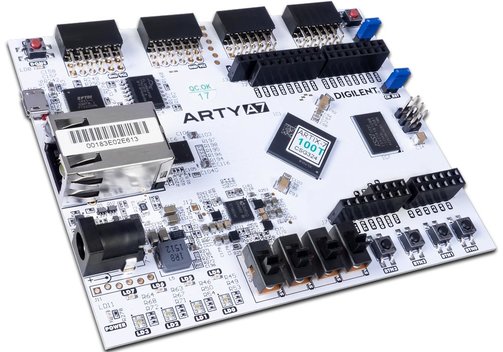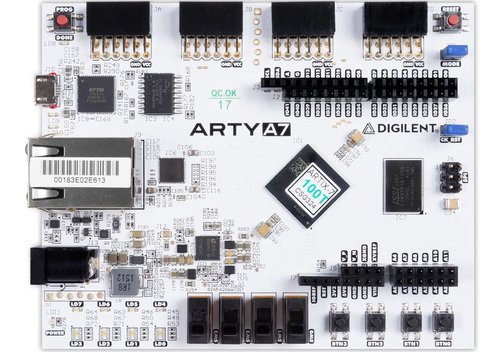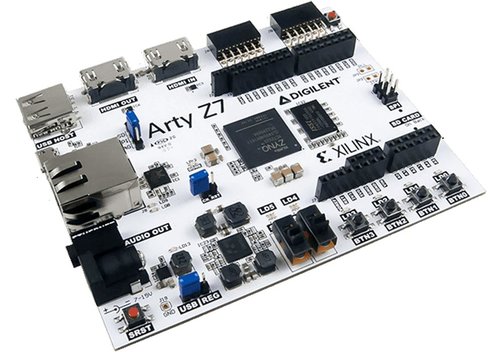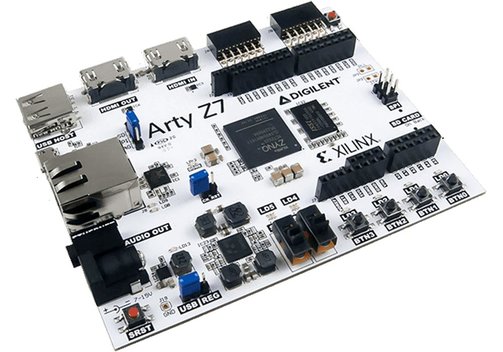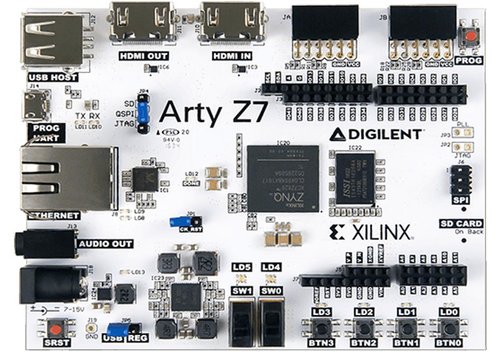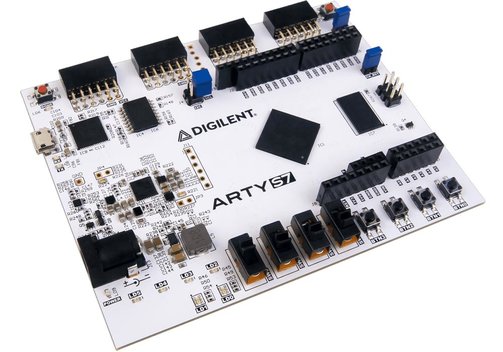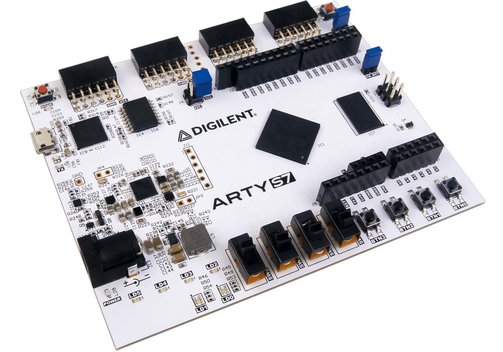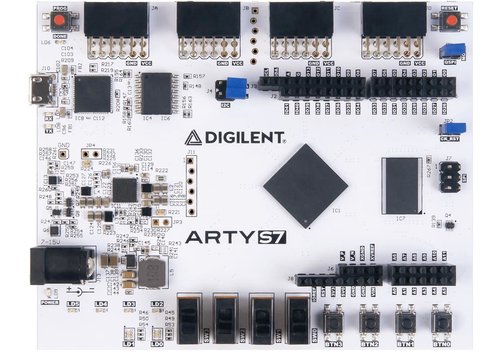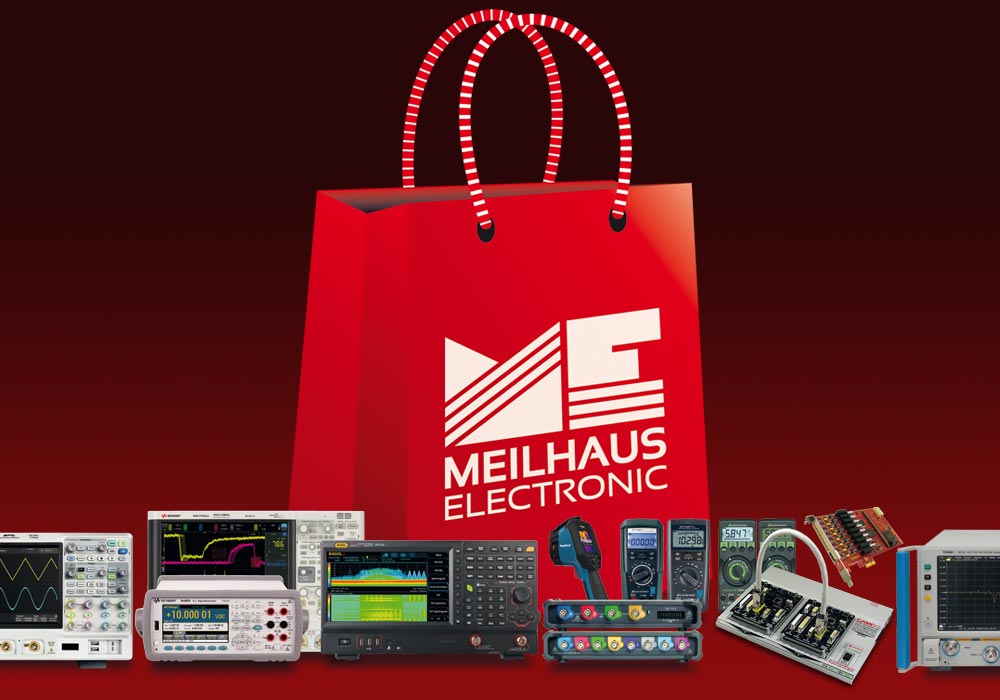Digilent Arty Serie Development Boards with Artix-7 FPGA, Zynq-7000 SoC, Spartan-7 FPGA
starting €
165,41
including VAT
plus shipping
close
Please fill in all fields.
Question Type
Your E-mail Adress
My Question:
Please validate that you are not a robot.
Description
Files/Downloads
Digilent Arty Serie Development Boards with Artix-7 FPGA, Zynq-7000 SoC, Spartan-7 FPGA
The Digilent Arty family of FPGA/SoC boards was designed with versatility and flexibility in mind. With universally popular Arduino headers and multiple Pmod ports, the Arty is the very adaptable FPGA/SoC board.
- The Arty A7 is a ready-to-use development platform designed around the Xilinx Artix-7 FPGA family. With the Artix-7 devices, the Arty A7 board provides the highest performance-per-watt fabric, transceiver line rates, DSP processing, and AMS integration in the Arty family. With the MicroBlaze Soft Processor Core from Xilinx, you can create embedded applications with a variety of peripherals, memory, and interfaces. The Arty A7 is supported by Xilinx's Vivado Design Suite, including the free WebPACK version. You can also leverage the Vitis Core Development Kit or Xilinx Software Development Kit to start developing for the MicroBlaze processor with no prior FPGA experience.
- The Arty Z7 is a ready-to-use development platform designed around the Xilinx Zynq-7000 System-on-a-chip (SoC) family. The Zynq-7000 SoC family integrates the software programmability of an ARM-based processor with the hardware programmability of an FPGA, enabling key analytics and hardware acceleration while integrating CPU, DSP, ASSP, and mixed signal functionality on a single device. The Arty Z7 is supported by Xilinx's Vivado Design Suite, including the free WebPACK version. The SDSoC Development Environment provides a familiar embedded C/C++/OpenCL application development experience for heterogeneous Zynq SoC deployment.
There are two variants of the Arty Z7: The Arty Z7-10 features the XC7Z010-1CLG400C, and the Arty Z7-20 features the larger XC7Z020-1CLG400C. - The Arty S7 is an affordable, ready-to-use development platform designed around the Xilinx Spartan-7 FPGA family. With the Spartan-7 devices, the Arty Spartan-7 development board offers best-in-class performance-per-watt, along with small form-factor packaging to meet the most stringent requirements. With the MicroBlaze Soft Processor Core from Xilinx, you can create embedded applications with a variety of peripherals, memory, and interfaces. With its user-friendly design and rich set of features, the Arty S7 makes FPGA development accessible and enjoyable. Whether you're working on educational projects, prototyping, or exploring innovative solutions, this Xilinx evaluation board is a reliable companion on your journey into the fascinating realm of programmable logic. The Arty S7 is supported by Xilinx's Vivado Design Suite, including the free WebPACK version. You can also leverage the Vitis Core Development Kit or Xilinx Software Development Kit to start developing for the MicroBlaze processor with no prior FPGA experience.
There are two variants of the Arty S7: The Arty S7-25 features the XC7S25-CSGA324, and the Arty S7-50 features the larger XC7S50-CSGA324.
Model Overview
| Model | Arty A7-100T | Arty Z7-10 | Arty Z7-20 | Arty S7-25 | Arty S7-50 |
| 410-319-1 | 410-346-10 | 410-346-20 | 410-352-25 | 410-352 | |
| Description | Artix-7 FPGA development board | Zynq-7000 SoC development board | Zynq-7000 SoC development board | Spartan-7 FPGA development board | Spartan-7 FPGA development board |
| FPGA features | XC7A100TCSG324-1. Logic cells 101,440. DSP slices 240. Memory 4,860 kbits. Internal clock speeds exceeding 450 MHz. On-chip analog-to-digital converter (XADC). Programmable over JTAG and Quad-SPI Flash. | XC7Z010-1CLG400C. Logic cells 28,000. DSP slices 80. Block RAM 2.1 Mbits. | XC7Z020-1CLG400C. Logic eclls 85,000. DSP slices 220. Block RAM 4.9 Mbits. | XC7S25-CSGA324. 1 MS/s on-chip ADC. Logic cells 23,360. Slices 3,650. Flip-flops 29,200. Block RAM 1,620 kbits. Clock management tiles 3. DSP slices 80. | XC7S50-CSGA324. 1 MS/s on-chip ADC. Logic cells 52,160. Slices 8,150. Flip-flops 65,200. Block RAM 2,700 kbits. Clock management tiles 5. DSP slices 120. |
| Internal clock speeds exceeding 450 MHz. On-chip analog-to-digital converter (XADC). Programmable over JTAG and Quad-SPI Flash. | |||||
| System features | 256 MB DDR3L with a 16-bit bus at 333 MHz (667 MT/s). 16 MB Quad-SPI Flash (due to supply chain constraints, either the S25FL127S or S25FL128S Flash Memory may be loaded on your board. These parts are not functionally equivalent, but flash programming through Vivado and the QSPI boot mode are not affected). USB-JTAG programming circuitry (Micro B USB cable required). Powered from USB or any 7...15 V source. |
ZYNQ processor. 650 MHz dual-core Cortex-A9 processor. DDR3 memory controller with 8 DMA channels and 4 high performance AXI3 slave ports. High-bandwidth peripheral controllers: 1G Ethernet, USB 2.0, SDIO. Low-bandwidth peripheral controller: SPI, UART, CAN, I2C. Programmable from JTAG, Quad-SPI flash, and microSD card (Micro B USB cable NOT included, but can be added for free!). Programmable logic equivalent to Artix-7 FPGA Memory: 512 MB DDR3 with a 16-bit bus at 525 MHz (1050 MT/s). 16 MB Quad-SPI Flash with factory programmed 48-bit globally unique EUI-48/64 compatible identifier. microSD slot. Power: Powered from USB or any 7V-15V external power source. | 256 MB DDR3L with a 16-bit bus at 325 MHz (650 MT/s). 128 Mbits Quad-SPI Flash (due to supply chain constraints, either the S25FL127S or S25FL128S Flash Memory may be loaded on your board. These parts are not functionally equivalent, but flash programming through Vivado and the QSPI boot mode are not affected). 100 MHz external clock. USB-JTAG programming circuitry (Micro B USB cable required - add one free with your FPGA purchase). Powered from USB or any 7...15 V source. | ||
| System connectivity | 10/100 Mbps Ethernet. USB-UART bridge. | USB and Ethernet. Gigabit Ethernet PHY. USB-JTAG programming circuitry. USB-UART bridge. USB OTG PHY (supports host only) Audio and Video: HDMI sink port (input). HDMI source port (output). PWM driven mono audio output with 3.5-mm jack. | USB-UART bridge. | ||
| Interaction and sensory devices | 4 switches. 4 buttons. 1 reset button. 4 LEDs. 4 RGB LEDs. | 4 push-buttons. 2 slide switches. 4 LEDs. 2 RGB LEDs. | 4 switches. 4 buttons. 1 reset board button. 1 FPGA reset button. 4 green LEDs. 2 RGB LEDs. | ||
| Expansion connectors | 4 Pmod connectors. Arduino/chipKIT shield connector. | Two standard Pmod ports. 16 total FPGA I/O. Arduino/chipKIT shield connector: Up to 49 FPGA digital-I/O for the Z7-20 and 26 FPGA digital-I/O for the Z7-10; 6 single-ended 0...3.3 V analog inputs to XADC; 4 differential 0...1.0 V analog inputs to XADC. | 4 Pmod connectors. Arduino/chipKIT shield connector. | ||
| Product compliance | HTC: 8471500150. ECCN: EAR99. | HTC: 8471500150. ECCN: 5A992.c. | HTC: 8471500150. ECCN: 5A992.c. | ||
Information on product safety:
Manufacturer:
Digilent (now a part of Emerson), 1300 NE Henley Ct. Suite 3, Pullman, WA 99163/USA
www.digilent.com
Responsible person:
Meilhaus Electronic GmbH, Am Sonnenlicht 2, 82239 Alling/DEU
info@meilhaus.com
Last seen
























